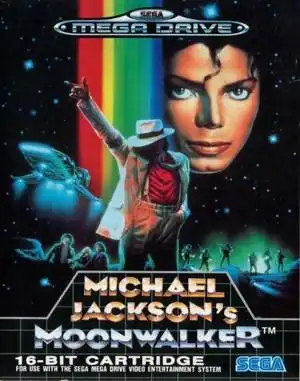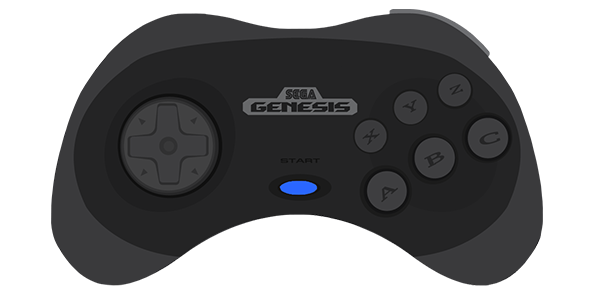Remember a time when licensed video games weren't just quick cash grabs, but sometimes genuinely bizarre, yet utterly memorable experiences? If you were gaming in the late '80s and early '90s, chances are you encountered Michael Jackson's Moonwalker. More than just a game based on a movie, it was a digital embodiment of MJ's unique persona, translated into pixels and sound chips across multiple, wildly different versions.
This wasn't just one game; it was a whole family of games, each offering a distinct flavor of Michael Jackson magic (and occasional weirdness). Let's take a nostalgic trip back to rescue kidnapped children, bust out dance moves to defeat enemies, and maybe even turn into a robot. It's a game that perfectly encapsulates the sometimes weird, always memorable charm of retro gaming.
The Sega Genesis/Mega Drive Version: Platforming Pop Star
For many console gamers, the Sega Genesis (or Mega Drive outside North America) version is the definitive Moonwalker experience. This was primarily a platformer, tasking you with navigating levels, beating up bad guys, and finding hidden children.
Gameplay: Kicks, Sparkles, and Dance Magic
Playing as Michael, you'd traverse graveyards, caves, and city streets, all while iconic MJ tunes played in the background (though sometimes in slightly... unique synthesized versions). Your standard attack was a surprisingly effective high kick. Holding the attack button while moving backward triggered the signature moonwalk, often leaving a trail of sparkly magic that could damage foes.
The real fun came with the special attack. Tapping the button might throw your hat like a boomerang, but holding it down initiated the "Dance Magic" move. Michael would strike a pose, and enemies around him would be compelled to dance along before exploding! This cost you a bit of health, making it a strategic, albeit flashy, option.
Finding hidden children was the main objective, often tucked away in unexpected places like behind doors or under objects. Rescuing them would restore your health. And if you found Bubbles the chimpanzee? Prepare for a temporary transformation into Robo-Jackson, a laser-shooting powerhouse!
Why It Was Memorable (and a Little Strange)
The Genesis Moonwalker was a mixed bag in terms of gameplay polish, but its sheer personality made it stick. The idea of defeating gangsters with dance moves was inherently silly and brilliant. The graphics were decent for the era, capturing some of the film's aesthetic, particularly the "Smooth Criminal" set pieces. Despite some repetitive level design, the core loop of exploring, finding kids, and busting out dance moves was undeniably engaging for fans.
The Sega Arcade Version: Beat 'Em Up Bliss
While the Genesis version hit homes, Sega also released a completely different Moonwalker in arcades. This one was an isometric beat 'em up, allowing up to three players to team up as different-colored Michael Jacksons.
Gameplay: Isometric Action and Collective Dance
The arcade game felt more action-focused. You'd move through stages from an overhead, angled perspective, using magic blasts, spinning attacks, and charged shots to clear screens of enemies. The "Dance Magic" was still here, but felt even more impactful with multiple players clearing the screen in a synchronised pixelated boogie.
Finding Bubbles in this version also triggered the Robo-Jackson transformation, turning the game into a temporary mech shooter. It was a cool power-up that added variety to the brawling.
Arcade vs. Console: A Tale of Two Games
It's crucial to understand these were not ports of each other. The arcade game was a pure beat 'em up designed for coin-op action, while the Genesis game was a platformer tailored for home play. Both were based on the film and featured similar themes (rescuing kids from Mr. Big, using MJ's moves), but their gameplay mechanics and level designs were entirely distinct. The arcade version is generally considered more polished as a pure action game.
The Home Computer Versions: The Wildcards
Beyond the Sega versions, U.S. Gold published Moonwalker for various home computers like the Amiga, Atari ST, Commodore 64, ZX Spectrum, and DOS. These versions were developed by different teams and were arguably the most eclectic of the bunch.
Varied Gameplay: From Mazes to Shooters
Instead of a single consistent style, the computer versions often featured multiple levels with completely different gameplay mechanics. You might start in a top-down maze, then switch to a motorcycle chase, followed by a side-scrolling shooter based on "Smooth Criminal," and finally a level where you control a robot Michael in a shooting gallery style.
This multi-genre approach was common for licensed computer games of the era but made the U.S. Gold Moonwalker feel less cohesive than its Sega counterparts. Still, they offered a unique, if sometimes clunky, way to experience the Moonwalker story on your PC.
How to Play Moonwalker Today
Feeling that wave of nostalgia? You can still revisit Michael Jackson's Moonwalker!
- Sega Genesis/Mega Drive: Emulators like Kega Fusion or RetroArch can run the ROMs. Original cartridges are also available on the secondary market.
- Sega Arcade: The MAME emulator is the way to go for experiencing the arcade beat 'em up.
- Home Computer Versions: DOS versions can often be run using DOSBox. Other computer versions might require specific emulators (e.g., WinUAE for Amiga, Fuse for ZX Spectrum). Sometimes, abandonware sites like Archive.org host playable browser versions.
Remember to source ROMs and game files responsibly and legally where possible.
Legacy and Lasting Impact
While perhaps not reaching the legendary status of Sonic the Hedgehog, Michael Jackson's Moonwalker remains a fascinating footnote in video game history. It showcases a unique collaboration between a global superstar and a major game developer (Sega) and highlights the wildly different approaches game companies took to licensed properties across platforms in that era. It's a game that perfectly encapsulates the sometimes weird, always memorable charm of retro gaming.
Frequently Asked Questions
Are the Sega Genesis and Arcade versions of Moonwalker the same game?
No, they are completely different games. The Genesis version is primarily a platformer, while the arcade version is an isometric beat 'em up. They share the theme and characters but have distinct gameplay mechanics and level designs.
How can I play Michael Jackson's Moonwalker on PC today?
You can play the Genesis version using emulators like Kega Fusion or RetroArch. The arcade version requires the MAME emulator. The old PC/DOS versions can typically be run using DOSBox.
What is the "Dance Magic" move?
It's Michael Jackson's special attack in the Sega versions. By holding down the special attack button, Michael initiates a dance routine that forces all on-screen enemies to dance along before being defeated, costing a portion of Michael's health.
Is Bubbles the chimpanzee in all versions?
Bubbles appears in the Sega Arcade and Genesis versions, leading Michael to the boss or triggering the Robo-Jackson transformation. He is typically absent from the home computer versions.
Whether you first played it in a smoky arcade, on your Sega console hooked up to a CRT TV, or on a clunky home computer, Michael Jackson's Moonwalker offered a unique, slightly bizarre, and undeniably entertaining experience. It's a perfect example of the creativity and sometimes questionable design choices that made the retro gaming era so special. Go on, dust off an emulator and moonwalk down memory lane!


